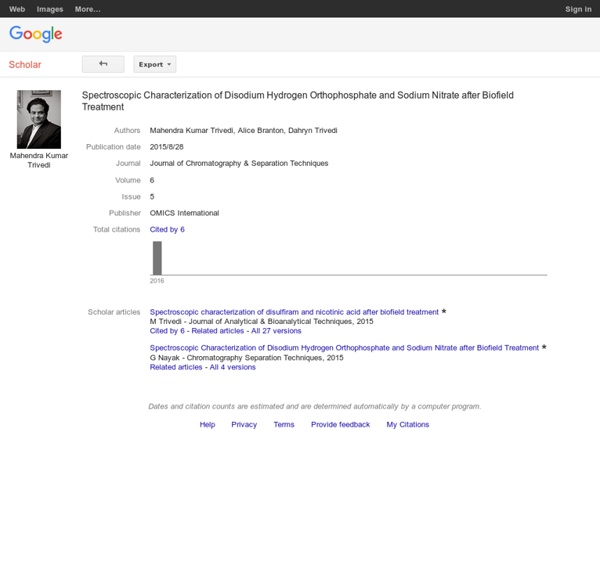



Spectroscopic Characterization of Disodium Hydrogen Orthophosphate and Sodium Nitrate after Biofield Treatment Open Access Trivedi et al., J Chromatogr Sep Tech 2015, 6:5 Research Article Open Access Chromatography Separation Techniques o u r n a l f h m t g p y e i c q s Volume 6 • Issue 5 • 1000282 J Chromatogr Sep Tech ISSN: 2157-7064 JCGST, an open access journal Spectroscopic Characterization of Disodium Hydrogen Orthophosphate and Sodium Nitrate after Biofield Treatment Mahendra Kumar Trivedi1, Alice Branton1, Dahryn Trivedi1, Gopal Nayak1, Khemraj Bairwa2 and Snehasis Jana2* 1Trivedi Global Inc., 10624 S Eastern Avenue Suite A-969, Henderson, NV 89052, USA 2Trivedi Science Research Laboratory Pvt. *Corresponding author: Snehasis Jana, Trivedi Science Research Laboratory Pvt. Bhopal-462026, Madhya Pradesh, India, Tel: +91-755-6660006; Fax: +91-755- 6660006; E-mail: publication@trivedisrl.com Received July 25, 2015; Accepted August 10, 2015; Published August 20, 2015 Citation: Trivedi MK, Branton A, Trivedi D, Nayak G, Bairwa K, et al. (2015) doi:10.4172/2157-7064.1000282 Abstract
Characterization of Physical and Structural Properties of Aluminium Carbide Powder: Impact of Biofield Treatment | Mahendra Kumar Trivedi | Rama Mohan Tallapragada | Alice Branton | Dahryn Trivedi | Gopal Nayak Title: Characterization of Physical and Structural Properties of Aluminium Carbide Powder: Impact of Biofield Treatment Publication: Aeronautics & Aerospace Engineering Select license: Creative Commons Attributions-NonCommercial-ShareAlike Updated: November 19th, 2016 Abstract: Aluminium carbide (Al4C3) has gained extensive attention due to its abrasive and creep resistance properties.
Publication meta - Characterization of Physical, Thermal and Structural Properties of Chromium (VI) Oxide Powder: Impact of Biofield Treatment Chromium (VI) oxide (CrO3) has gained extensive attention due to its versatile physical and chemical properties. The objective of the present study was to evaluate the impact of biofield treatment on physical, thermal and structural properties of CrO3 powder. In this study, CrO3 powder was divided into two parts i.e. control and treatment. Control part was remained as untreated and treated part received Mr. Trivedi’s biofield treatment. Subsequently, control and treated CrO3 samples were characterized using Thermo gravimetric analysis-differential thermal analysis (TGA-DTA), X-ray diffraction (XRD), and Fourier transform infrared spectroscopy (FT-IR).
Spectroscopic Characterization of Disodium Hydrogen Orthophosphate and Sodium Nitrate after Biofield Treatment Share this: Embed* Cite this: Trivedi, Mahendra Kumar; Branton, Alice; Trivedi, Dahryn; Nayak, Gopal; Bairwa, Khemraj; Jana, Snehasis (2015): Spectroscopic Characterization of Disodium Hydrogen Orthophosphate and Sodium Nitrate after Biofield Treatment. figshare. Retrieved 11:10, Oct 30, 2015 (GMT) *The embed functionality can only be used for non commercial purposes. Description Disodium hydrogen orthophosphate is a water soluble white powder widely used as pH regulator and saline laxative. Overall, the FT-IR and UV spectroscopic data of both compounds suggest an impact of biofield treatment on spectral properties with respect to force constant, bond strength, dipole moments and transition energy between two orbitals (ground state and excited state) as compared to respective control. Comments (0) Published on 03 Oct 2015 - 13:35 (GMT) Filesize is 728.17 KB License (what's this?) Cite "Filename" Place your mouse over the citation text to select it
Publication meta - Spectroscopic Characterization of Disodium Hydrogen Orthophosphate and Sodium Nitrate after Biofield Treatment Disodium hydrogen orthophosphate is a water soluble white powder widely used as pH regulator and saline laxative. The sodium nitrate is a highly water soluble white solid, used in high blood pressure, dentinal hypersensitivity, and production of fertilizers. The present study was aimed to investigate the impact of biofield treatment on spectral properties of disodium hydrogen orthophosphate and sodium nitrate. The study was performed in two groups i.e., control and treatment of each compound. The treatment groups were subjected to Mr. Evaluation of Biofield Treatment Dose and Distance in a Model of Cancer Cell Death An Emerging Global Opportunistic Pathogen | Trivedi Science Abstract Stenotrophomonas maltophilia ( S. maltophilia ) is a Gram-negative bacillus, an opportunistic pathogen, particularly among nosocomial infections. Multi-drug resistant strains are associated with very high rate of morbidity and mortality in severely immunocompromised patients. Present study was designed to evaluate the effect of biofield treatment against multidrug resistant S. maltophilia . Clinical sample of S. maltophilia was collected and divided into two groups i.e. control and biofield treated which were analyzed after 10 days with respect to control. Keywords: Stenotrophomonas maltophilia ; Multidrug resistant; Antimicrobial susceptibility; Biofield treatment; Biochemical reactions; Biotyping Introduction During the last few decades, due to the continuous deployment of antimicrobial drugs, incidence of microbial resistance has increased leads to generating multi-drug-resistance (MDR) organisms (MDROs). Materials and Methods Test micro-organism and experimental design Results
Biofield Treatment: An Alternative Approach to Combat Multidrug-Resistant Susceptibility Pattern of Raoultella ornithinolytica - Trivedi Science Abstract Raoultella ornithinolytica is belongs to the family of Enterobacteriaceae, a Gram-negative encapsulated aerobic bacillus associated with bacteremia and urinary tract infections. As biofield therapy is increasingly popular in biomedical heath care, so present study aimed to evaluate the impact of Mr. Biochemical reaction study showed 15.15% alteration in different biochemical such as cetrimide, cephalothin, kanamycin, and ornithine after biofield treatment as compared to control. Keywords: Raoultella ornithinolytica ; Biofield treatment; Antimicrobial susceptibility; Biochemical reaction; Biotype; Multidrug resistant Introduction Genus Raoultella belongs to the family Enterobacteriaceae, mainly contains Gram-negative, aerobic, non-motile, capsulated, and facultative anaerobic bacilli [1]. Although most of the infectious cases are often associated with underlying existing infection especially malignancies. Material and Methods Experimental design and biofield treatment Results 1.